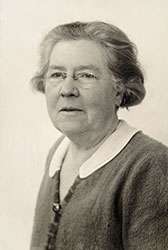Dorothy Cayley
| Dorothy Mary Cayley | |
|---|---|
 | |
| Born |
1874 Sri Lanka |
| Died | 1955 |
| Nationality | British |
| Occupation | Mycologist |
| Known for | discovered Tulip breaking virus |
Dorothy Mary Cayley (1874-1955) was a mycologist who discovered in 1927 that "Tulip breaking" is due to a virus.
Life
Cayley came to England from Sri Lanka when she was seven and attended Stamford High School. She had been born in Ceylon where her father, Sir Richard Cayley, was the 14th Chief Justice. She went to London University before studying horticulture at University College, Reading.[1]
She was educated in Stamford High School, then later moved to Germany where she studied music. She studied science for some time before going to University College in Reading where she received a diploma for horticulture.[1]
Achievements
Cayley was especially interested in plant disease and soils and entered the board of education's examination in Horticulture which gained her first-class honours and a medal while in Reading. She also took a first class in the Royal Horticultural Society Examination and was appointed as the Superintendent of the gardens that belonged to the Botanical Department at Reading.
Dorothy was also a talented artist, she drew the fungus she was examining and took her paint on holidays.[1]
World War 1
In 1910 Cayley did volunteer work at the John Innes Centre, she was forced to work in the attic of the Manor House before the laboratories were built. Bateson offered her a minor studentship in 1911. Between 1914 and 1918 She contributed to the war by doing a wide range of war work such as: Cutting bracken in Savernake Forest for army horse bedding and to tool setting for vickers airplane factory. She resigned from her minor studentship in 1916 to commit to helping for the last 18 months of the war. Dorothy assisted the Royal Army Medical investigations for Tetanus at the Lister Institute of Preventive Medicine in London. In 1919 she returned to the John Innes Centre and was appointed as a student, later that year she was given the title 'Mycologist'.[1]
Discoveries
She was a founding member of the Genetical Society in 1919 and introduced the study of the genetics of fungi into the United Kingdom. She found that the pretty phenomena of "Tulip Breaking" was due to a virus that was probably spread. This unusual colour variation did not result from genetics. Tulip enthusiasts who wanted "true colours" were pleased as they found the changes annoying. Cayley not only found the cause but also suggested a cure.[2] She published her findings in 1928.[3] More mundanely Cayley was interested in slime moulds and she created a better understanding on the sexual reproduction in moulds.[1]
Dorothy retired in 1938, and a year later she was the vice president of the British Mycological Society in 1939.[1]
References
- 1 2 3 4 5 6 Dorothy Cayley, JIC, Retrieved 28 May 2016
- ↑ JIC timeline, JIC, retrieved 28 May 2016
- ↑ Annals of Applied Biology in November 1928